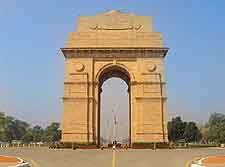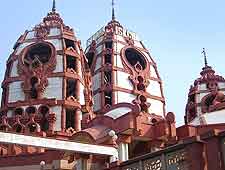New Delhi History Facts and Timeline
(New Delhi, Delhi, India)

The history of India's capital, New Delhi, began in the second decade of the 1900s, during the country's British colonial era. Its overall design was planned by famous British architects of the time, Sir Edwin Lutyens and Sir Herbert Baker.
Now a sophisticated world city, New Delhi is set to the south of Mughal Emperor Shah Jahan's Old Delhi, on the foundations of several ancient settlements. It combines the old and the new with its historic monuments, museums and stunning modern buildings.
New Delhi During the British Raj
The transference of governance and administration from the historic Indian capital of Calcutta, on the country's east coast, to the northern city of Delhi was first mooted in the early 1900s as a way to simplify the British Empire's control of its colony. King George V, in his capacity as Emperor of India, announced the transfer on 12th December 1911, laying the first foundation stone three days later during an imperial visit to the country. This was followed by its official formal inauguration as a city on 13th February 1911, while the centenary was celebrated as recently as 11th December 2011.
The New Capital
Construction of the new Imperial capital took off after the end of WWI and was completed by 1931, with New Delhi's main boulevard, the Rajpath (King's Way), running from the India Gate to the Rashtrapati Bhawan (Presidential House). This boulevard was lined with magnificent colonial buildings culminating in the Viceregal Palace on Raisina Hill, situated opposite the Dinapanah Citadel.
Other heritage buildings designed by Sir Herbert Baker, including the Secretariat and Parliament House, are found along the parallel street of Sansad Marg, with development of the city continuing right up until Indian independence in 1947.

The Post-Independence Era
After India gained independence, New Delhi soon became a hub for embassies, high commissions and ambassadorial mansions, all set in the new diplomatic district of Chanakyapuri. As the urban area spread, it encompassed ancient monuments redolent of the history of New Delhi itself, including the UNESCO World Heritage sites of the Qutub Minar and Humayun's Tomb. Massive modern residential districts soon filled every available space and new townships spread out from the original city boundaries.
Modern Days
Nowadays, New Delhi is writing its own history, with spectacular modern structures such as the beautiful Bahai Lotus Temple drawing as many visitors as its famous Red Fort. Further attractions include the 17th-century Jama Masjid mosque, the 18th-century white marble Gurudwara Rakab Ganj Sikh temple and the ruins of the massive Tughlaqabad Fort, built in the 14th century.
The city of New Delhi has become a centre for many religions, with iconic temples set side by side stunning Art Deco and imposing colonial-style buildings.
 The history of India's capital, New Delhi, began in the second decade of the 1900s, during the country's British colonial era. Its overall design was planned by famous British architects of the time, Sir Edwin Lutyens and Sir Herbert Baker.
The history of India's capital, New Delhi, began in the second decade of the 1900s, during the country's British colonial era. Its overall design was planned by famous British architects of the time, Sir Edwin Lutyens and Sir Herbert Baker.